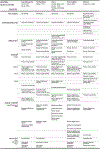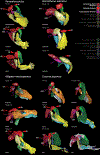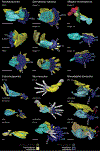Embryonic muscle splitting patterns reveal homologies of amniote forelimb muscles
- PMID: 35314784
- PMCID: PMC9090950
- DOI: 10.1038/s41559-022-01699-x
Embryonic muscle splitting patterns reveal homologies of amniote forelimb muscles
Abstract
Limb muscles are remarkably complex and evolutionarily labile. Although their anatomy is of great interest for studies of the evolution of form and function, their homologies among major amniote clades have remained obscure. Studies of adult musculature are inconclusive owing to the highly derived morphology of modern amniote limbs but correspondences become increasingly evident earlier in ontogeny. We followed the embryonic development of forelimb musculature in representatives of six major amniote clades and found, contrary to current consensus, that these early splitting patterns are highly conserved across Amniota. Muscle mass cleavage patterns and topology are highly conserved in reptiles including birds, irrespective of their skeletal modifications: the avian flight apparatus results from slight early topological modifications that are exaggerated during ontogeny. Therian mammals, while conservative in their cleavage patterns, depart drastically from the ancestral amniote musculoskeletal organization in terms of topology. These topological changes occur through extension, translocation and displacement of muscle groups later in development. Overall, the simplicity underlying the apparent complexity of forelimb muscle development allows us to resolve conflicting hypotheses about homology and to trace the history of each individual forelimb muscle throughout the amniote radiations.
© 2022. The Author(s), under exclusive licence to Springer Nature Limited.
Conflict of interest statement
Conflict of interest
The authors declare no conflict of interest.
Figures















Similar articles
-
Comparative anatomy, homologies and evolution of the pectoral and forelimb musculature of tetrapods with special attention to extant limbed amphibians and reptiles.J Anat. 2010 Nov;217(5):536-73. doi: 10.1111/j.1469-7580.2010.01278.x. Epub 2010 Aug 30. J Anat. 2010. PMID: 20807270 Free PMC article. Review.
-
The fossil record of appendicular muscle evolution in Synapsida on the line to mammals: Part I-Forelimb.Anat Rec (Hoboken). 2024 May;307(5):1764-1825. doi: 10.1002/ar.25312. Epub 2023 Sep 19. Anat Rec (Hoboken). 2024. PMID: 37726984
-
Specialize or risk disappearance - empirical evidence of anisomerism based on comparative and developmental studies of gnathostome head and limb musculature.Biol Rev Camb Philos Soc. 2015 Aug;90(3):964-78. doi: 10.1111/brv.12142. Epub 2014 Aug 30. Biol Rev Camb Philos Soc. 2015. PMID: 25174804 Review.
-
Complete forelimb myology of the basal theropod dinosaur Tawa hallae based on a novel robust muscle reconstruction method.J Anat. 2014 Sep;225(3):271-97. doi: 10.1111/joa.12216. Epub 2014 Jul 12. J Anat. 2014. PMID: 25040486 Free PMC article.
-
Anatomy of the pectoral and forelimb muscles of wildtype and green fluorescent protein-transgenic axolotls and comparison with other tetrapods including humans: a basis for regenerative, evolutionary and developmental studies.J Anat. 2012 Dec;221(6):622-35. doi: 10.1111/j.1469-7580.2012.01567.x. Epub 2012 Sep 7. J Anat. 2012. PMID: 22957800 Free PMC article.
Cited by
-
Distinct patterning responses of wing and leg neuromuscular systems to different preaxial polydactylies.Front Cell Dev Biol. 2023 May 4;11:1154205. doi: 10.3389/fcell.2023.1154205. eCollection 2023. Front Cell Dev Biol. 2023. PMID: 37215090 Free PMC article.
-
Forelimb muscle activation patterns in American alligators: Insights into the evolution of limb posture and powered flight in archosaurs.J Anat. 2024 Jun;244(6):943-958. doi: 10.1111/joa.14011. Epub 2024 Jan 19. J Anat. 2024. PMID: 38242862 Free PMC article.
-
Gross anatomy of the gluteal and posterior thigh muscles in koalas based on their innervations.PLoS One. 2022 Sep 14;17(9):e0261805. doi: 10.1371/journal.pone.0261805. eCollection 2022. PLoS One. 2022. PMID: 36103546 Free PMC article.
-
Unusual Duplication of Flexor Tendons in the Middle Finger Leading to Trigger Finger: A Case Report and Comprehensive Review.Cureus. 2024 May 18;16(5):e60539. doi: 10.7759/cureus.60539. eCollection 2024 May. Cureus. 2024. PMID: 38887356 Free PMC article.
-
The origin of vertebrate teeth and evolution of sensory exoskeletons.Nature. 2025 Jun;642(8066):119-124. doi: 10.1038/s41586-025-08944-w. Epub 2025 May 21. Nature. 2025. PMID: 40399678 Free PMC article.
References
-
- Howell AB Morphogenesis of the shoulder architecture. Part IV. Reptilia. The Quarterly Review of Biology 11, 183–208 (1936).
-
- Howell AB Phylogeny of the distal musculature of the pectoral appendage. Journal of Morphology 60, 287–315 (1936).
-
- Howell AB Morphogenesis of the shoulder architecture: Aves. The Auk 54, 364–375 (1937).
-
- Howell AB Morphogenesis of the shoulder architecture. Part VI. Therian Mammalia. The Quarterly Review of Biology 12, 440–463 (1937).
-
- Howell AB Morphogenesis of the shoulder architecture. Part V. Monotremata. The Quarterly Review of Biology 12, 191–205 (1937).
Publication types
MeSH terms
Associated data
Grants and funding
LinkOut - more resources
Full Text Sources

